![The Hidden Fortress (4K UHD) [Blu-ray] [Region A & B & C]](/pictures/1168908.jpg) The Hidden Fortress (4K UHD) | Blu Ray | (18/08/2025)
from £22.98
| Saving you £N/A (N/A%)
| RRP
The Hidden Fortress (4K UHD) | Blu Ray | (18/08/2025)
from £22.98
| Saving you £N/A (N/A%)
| RRP New 4K Restoration of Kurosawa's much-loved classic. A story of rival clans, hidden gold and a princess in distress, The Hidden Fortress is a thrilling mix of fairy story and samurai action movie. It was Kurosawa's first film shot in the widescreen process of Tohoscope, and he exploited this to the full in the film's rich variety of landscape locations, including the slopes of Mount Fuji. The Hidden Fortress became Kurosawa's biggest box office hit to date and won several awards, including the Golden Bear at the 1959 Berlin Film Festival. Some twenty years on, the film's influence would have even greater impact on the world's box office, when George Lucas borrowed elements of its plot for the first of his Star Wars series. Extras Restored 4K (2160p) UHD Blu-ray presentation in Dolby Vision (HDR10 compatible) Newly recorded audio commentary by Japanese-cinema expert Tony Rayns Akira Kurosawa: It is Wonderful to Create Hidden Fortress (2002) Interview with George Lucas (2001, 8 mins) Original trailer **FIRST PRESSING ONLY** Illustrated booklet with a new essay on the film by Kenta McGrath
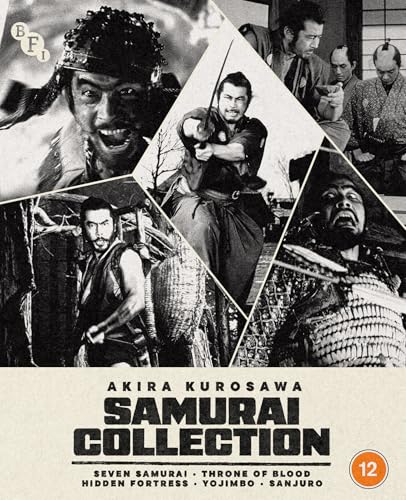 Akira Kurosawa Samurai Collection (Blu-ray) | Blu Ray | (01/12/2025)
from £39.34
| Saving you £N/A (N/A%)
| RRP
Akira Kurosawa Samurai Collection (Blu-ray) | Blu Ray | (01/12/2025)
from £39.34
| Saving you £N/A (N/A%)
| RRP His influence on filmmakers throughout the entire world is so profound as to be almost incomparable' Martin Scorsese Akira Kurosawa is one of the world's greatest filmmakers. His films have been acclaimed by critics and audiences the world over, and his celebrated samurai epics featuring international star Toshiro Mifune have inspired filmmakers as diverse as Steven Spielberg and Sergio Leone, and countless films, including The Magnificent Seven and Star Wars. This indispensable collection contains recently remastered presentations of five of Kurosawa's greatest films, accompanied by a wealth of extras features including documentaries, interviews, audio commentaries and original theatrical trailers. Extras 6-disc set featuring five classic Kurosawa films in High Definition Akira Kurosawa: It is Wonderful to Create (2002, 195 mins): five episodes of the Toho Masterworks series split over five discs, that take an in-depth look at each of the films included in this collection. Each episode includes interviews with not only Kurosawa himself but a host of cast and crew. Audio commentary on Seven Samurai by film critic Adrian Martin Philip Kemp selected scenes commentary on Seven Samurai (1999, 20 mins): film critic and writer Philip Kemp analyses key scenes from the film. The Art of Akira Kurosawa (2013, 49 mins): Asian-cinema expert Tony Rayns discusses Kurosawa's career and influence My Life in Cinema (1993, 116 mins): a conversation between filmmakers Akira Kurosawa and Nagisa Oshima filmed for the Directors Guild of Japan in 1993 - the two legendary directors discuss Kurosawa's life, career and legacy Introduction to Throne of Blood by Sir Ian McKellen (2016, 2 mins) Introduction to Throne of Blood by Mamoun Hassan (2012, 7 mins): the late writer, director, and producer introduces a screening of Akira Kurosawa's film at the BFI Southbank Audio commentary on Throne of Blood by Japanese film expert Michael Jeck Macbeth (1945, 16 mins): two scenes from Shakespeare's famous Scottish tragedy, with Wilfrid Lawson and Cathleen Nesbitt as a fine murderous duo Audio commentary on The Hidden Fortress by Japanese-film expert Tony Rayns BFI Screen Epiphanies: Steven Berkoff (2015, 18 mins): in a wide-ranging discussion with journalist Ian Hadyn Smith, the actor, writer and theatre director reflects on The Hidden Fortress, the talents of Toshiro Mifune and his first viewing of the film in the late 1950s Interview with George Lucas (2001, 8 mins) Original trailer Sword For Hire (2024, 25 mins): Kurosawa scholar Jasper Sharp discusses Yojimbo and Sanjuro in this analytical assessment Audio commentary on Yojimbo by film critic Philip Kemp Introduction to Sanjuro (2003, 5 mins): filmmaker Alex Cox introduces Sanjuro Audio commentary on Sanjuro by Japanese-Australian filmmaker Kenta McGrath Out of the Dust Storm and into the Koi Pond (2025, 18 mins): Nic Wassell considers the role of nature as a background to the machinations of mankind in role of nature as a background to the machinations of mankind in Yojimbo and Sanjuro Alex Cox on Kurosawa (2003, 9 mins): the director discusses the life and work of Akira Kurosawa Original Japanese trailers Seven Samurai trailer (2024) Image galleries for Seven Samurai, Yojimbo and Sanjuro
![Kurosawa Samurai Collection [Blu-ray]](/pictures/1132035.jpg) Kurosawa Samurai Collection | Blu Ray | (01/09/2014)
from £48.50
| Saving you £11.49 (23.69%)
| RRP
Kurosawa Samurai Collection | Blu Ray | (01/09/2014)
from £48.50
| Saving you £11.49 (23.69%)
| RRP The films of Akira Kurosawa one of the cinema's greatest auteurs have had a profound effect on audiences around the world and his acclaimed samurai epics - featuring international star Toshirô Mifune - have inspired filmmakers a diverse as George Lucas and Sergio Leone. This collection marks the first time all these seminal films have been available on High Definition blu-ray in the UK. Seven Samurai (1954)When the residents of a small Japanese village seek protection they hire seven unemployed ronin' (masterless samurai). Paid only in handfuls of rice the samurai remain distant from the villagers knowing that their assignment may prove to be fatal. Unanimously hailed as one of cinema's greatest masterpieces Seven Samurai has inspired countless films including The Magnificent Seven. Japan | 1954 | 190 minutes | Original aspect ratio 1.33:1 Throne of Blood (1957)In this brilliant re-imagining of Shakespeare's Macbeth Toshirô Mifune plays a samurai fated to betray his friend and master in exchange for the prestige of nobility. Kurosawa's bloody tale is a triumph of economic style and the climactic battle scene is full of remarkable and brutal imagery. Japan | 1957 | 104 minutes | Original aspect ratio 1.33:1 The Hidden Fortress (1958)In this classic collaboration between Kurosawa and star Mifune a warrior and a princess try against all odds to return to their homeland with their fortune. Acknowledged by George Lucas as the inspiration for Star Wars The Hidden Fortress combines an epic tale of struggle and honour with modern comic sensibilities to masterful effect. Japan | 1958 | 138 minutes | Original aspect ratio 2.35:1 (16x9 enhanced) Yojimbo (1961)A drifting samurai for hire plays both ends against the middle with two warring factions surviving on his wits and his ability to outrun his own bad luck. Eventually the samurai seeks to eliminate both sides for his own gain and to define his own sense of honour. Yojimbo provided inspiration for A Fistful of Dollars. Japan | 1961 | 106 minutes | Widecreen 4:3 format Sanjuro (1962)After the success of Yojimbo Kurosawa teamed up once again with Mifune one year later to make this comedy of manners. The film which follows a man fighting corruption in local government offers a twist on the classic Samurai tale by gently but perfectly parodying the conventions of the Japanese period action movie tradition. Japan | 1962 | 95 minutes | Original aspect ratio 2.35:1 (16x9 enhanced)
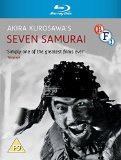 Seven Samurai (Blu-ray Edition) | Blu Ray | (25/08/2014)
from £18.98
| Saving you £3.00 (17.66%)
| RRP
Seven Samurai (Blu-ray Edition) | Blu Ray | (25/08/2014)
from £18.98
| Saving you £3.00 (17.66%)
| RRP One of the greatest films ever made – Akira Kurosawa’s Seven Samurai has influenced the work of directors from George Lucas to Steven Spielberg and spawned remakes such as John Sturges’ acclaimed The Magnificent Seven. With their village raided every year by vicious bandits a group of peasants hire seven warriors to protect them. Initially met with suspicion the warriors eventually gain the trust of the peasants and they join forces to face the bandits. This special edition includes alternative presentations of the film a new and exclusive interview with Asian cinema expert Tony Rayns and the film’s original Japanese trailer. Endlessly copied but never surpassed Seven Samurai is a truly timeless classic. Contents: Digitally re-mastered in High Definition Play with or without original intermission Original Japanese theatrical trailer The Art of Akira Kurosawa (2013 49 mins): Asian cinema expert Tony Rayns discusses Kurosawa’a career and influence Fully illustrated booklet with essays and credits
![Seven Samurai [1954]](/pictures/1004703.jpg) Seven Samurai | DVD | (22/11/1999)
from £14.98
| Saving you £5.01 (33.44%)
| RRP
Seven Samurai | DVD | (22/11/1999)
from £14.98
| Saving you £5.01 (33.44%)
| RRP Unanimously hailed as one of the greatest masterpieces in the history of the motion picture, Seven Samurai has inspired countless films modelled after its basic premise. But Akira Kurosawa's classic 1954 action drama has never been surpassed in terms of sheer power of emotion, kinetic energy, and dynamic character development. The story is set in the 1600s, when the residents of a small Japanese village are seeking protection against repeated attacks by a band of marauding thieves. Offering mere handfuls of rice as payment, they hire seven unemployed "ronin" (masterless samurai), including a boastful swordsman (Toshiro Mifune) who is actually a farmer's son desperately seeking glory and acceptance. The samurai get acquainted with but remain distant from the villagers, knowing that their assignment may prove to be fatal. The climactic battle with the raiding thieves remains one of the most breathtaking sequences ever filmed. It's poetry in hyperactive motion and one of Kurosawa's crowning cinematic achievements. This is not a film that can be well served by any synopsis; it must be seen to be appreciated and belongs on the short list of any definitive home-video library. --Jeff Shannon
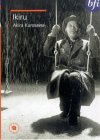 Ikiru | DVD | (06/10/2003)
from £18.75
| Saving you £1.24 (6.61%)
| RRP
Ikiru | DVD | (06/10/2003)
from £18.75
| Saving you £1.24 (6.61%)
| RRP ""Sometimes I think of my death "" wrote Akira Kurosawa ""I think of ceasing to be... and it is from these thoughts that Ikiru came."" The story of a man diagnosed with stomach cancer Kurosawa's film is a serious contemplation of the nature of existence and the question of how we find meaning in our lives. Opening with a shot of an x-ray showing the main character's stomach 'Ikiru' tells the tale of a dedicated downtrodden civil servant who diagnosed with a fatal cancer learns to c
![Rashomon [1950]](/pictures/1078426.jpg) Rashomon | DVD | (13/10/2008)
from £20.00
| Saving you £-0.01 (N/A%)
| RRP
Rashomon | DVD | (13/10/2008)
from £20.00
| Saving you £-0.01 (N/A%)
| RRP Famously, Rashomon - which won both the Golden Lion in Venice and the Oscar for Foreign-Language Film - introduced Western audiences to Japanese cinema in general and to the thrilling artistry of Akira Kurosawa in particular.
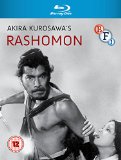 Rashomon (Blu-ray) | Blu Ray | (17/04/2019)
from £8.99
| Saving you £11.00 (122.36%)
| RRP
Rashomon (Blu-ray) | Blu Ray | (17/04/2019)
from £8.99
| Saving you £11.00 (122.36%)
| RRP This 1950 film by Akira Kurosawa is more than a classic: it's a cinematic archetype that has served as a template for many a film since. (Rashomon's most direct influence was on a Western remake, The Outrage, starring Paul Newman and directed by Martin Ritt.) In essence, the facts surrounding a rape and murder are told from four different and contradictory points of view, suggesting the nature of truth is something less than absolute. The cast, headed by Kurosawa's favourite actor, Toshiro Mifune, is superb. --Tom Keogh
![Akira Kurosawa - The Samurai Collection [DVD]](/pictures/1100983.jpg) Akira Kurosawa - The Samurai Collection | DVD | (07/06/2010)
from £35.19
| Saving you £4.80 (13.64%)
| RRP
Akira Kurosawa - The Samurai Collection | DVD | (07/06/2010)
from £35.19
| Saving you £4.80 (13.64%)
| RRP Akira Kurosawa: The Samurai Collection (5 Discs)
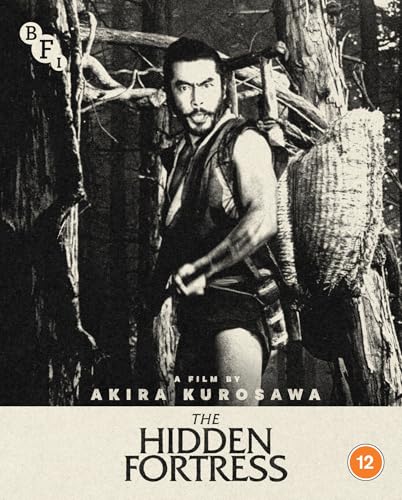 The Hidden Fortress (Blu-ray) | Blu Ray | (18/08/2025)
from £18.75
| Saving you £N/A (N/A%)
| RRP
The Hidden Fortress (Blu-ray) | Blu Ray | (18/08/2025)
from £18.75
| Saving you £N/A (N/A%)
| RRP New restoration of Kurosawa's much-loved classic. A story of rival clans, hidden gold and a princess in distress, The Hidden Fortress is a thrilling mix of fairy story and samurai action movie. It was Kurosawa's first film shot in the widescreen process of Tohoscope, and he exploited this to the full in the film's rich variety of landscape locations, including the slopes of Mount Fuji. The Hidden Fortress became Kurosawa's biggest box office hit to date and won several awards, including the Golden Bear at the 1959 Berlin Film Festival. Some twenty years on, the film's influence would have even greater impact on the world's box office, when George Lucas borrowed elements of its plot for the first of his Star Wars series. Extras Newly restored in 4K and presented in High Definition Newly recorded audio commentary by Japanese-cinema expert Tony Rayns Akira Kurosawa: It is Wonderful to Create Hidden Fortress (2002) Interview with George Lucas (2001, 8 mins) Original trailer **FIRST PRESSING ONLY** Illustrated booklet with a new essay on the film by Kenta McGrath
![Throne Of Blood [1957]](/pictures/1003692.jpg) Throne Of Blood | DVD | (22/10/2001)
from £12.61
| Saving you £7.38 (58.52%)
| RRP
Throne Of Blood | DVD | (22/10/2001)
from £12.61
| Saving you £7.38 (58.52%)
| RRP A champion of illumination and experimental shading, Kurosawa brings his unerring eye for indelible images to Shakespeare in this 1957 adaptation of Macbeth. By changing the locale from Birnam Wood to 16th-century Japan, Kurosawa makes an oddball argument for the trans-historicity of Shakespeare's narrative; and indeed, stripped to the bare mechanics of the plot, the tale of cut-throat ambition rewarded (and thwarted) feels infinitely adaptable. What's lost in the translation, of course, is the force and beauty of the language--much of the script of Throne of Blood is maddeningly repetitive or superfluous--but striking visual images (including the surreal Cobweb Forest and some extremely artful gore) replace the sublime poetry. Toshiro Mifune is theatrically intense as Washizu, the samurai fated to betray his friend and master in exchange for the prestige of nobility; he portrays the ill-fated warrior with a passion bordering on violence, and a barely concealed conviviality. Somewhat less successful is Isuzu Yamada as Washizu's scheming wife; her poise and creepy impassivity, chilling at first, soon grows tedious. Kurosawa himself is the star of the show, though, and his masterful use of black-and-white contrast--not to mention his steady, dramatic hand with a battle scene--keeps the proceedings thrilling. A must-see for fans of Japanese cinema, as well as all you devotees of samurai weapons and armour. --Miles Bethany
 Rashomon (DVD) | DVD | (21/09/2015)
from £18.48
| Saving you £3.27 (19.56%)
| RRP
Rashomon (DVD) | DVD | (21/09/2015)
from £18.48
| Saving you £3.27 (19.56%)
| RRP This 1950 film by Akira Kurosawa is more than a classic: it's a cinematic archetype that has served as a template for many a film since. (Rashomon's most direct influence was on a Western remake, The Outrage, starring Paul Newman and directed by Martin Ritt.) In essence, the facts surrounding a rape and murder are told from four different and contradictory points of view, suggesting the nature of truth is something less than absolute. The cast, headed by Kurosawa's favourite actor, Toshiro Mifune, is superb. --Tom Keogh
![Hidden Fortress [1958]](/pictures/1006132.jpg) Hidden Fortress | DVD | (25/03/2002)
from £19.99
| Saving you £N/A (N/A%)
| RRP
Hidden Fortress | DVD | (25/03/2002)
from £19.99
| Saving you £N/A (N/A%)
| RRP A story of rival clans hidden gold and a princess in distress The Hidden Fortress is a thrilling mix of fairy story and samurai action movie. It was Kurosawa's first film shot in the widescreen process of Tohoscope and he exploited this to the full in the film's rich variety of landscape locations including the slopes of Mount Fuji. The Hidden Fortress became Kurosawa's biggest box-office hit to date and won several awards including the Golden Bear at the 1959 Berlin Film Fest
![Rashomon [1950]](/pictures/1006201.jpg) Rashomon | DVD | (22/10/2001)
from £N/A
| Saving you £N/A (N/A%)
| RRP
Rashomon | DVD | (22/10/2001)
from £N/A
| Saving you £N/A (N/A%)
| RRP This 1950 film by Akira Kurosawa is more than a classic: it's a cinematic archetype that has served as a template for many a film since. (Rashomon's most direct influence was on a Western remake, The Outrage, starring Paul Newman and directed by Martin Ritt.) In essence, the facts surrounding a rape and murder are told from four different and contradictory points of view, suggesting the nature of truth is something less than absolute. The cast, headed by Kurosawa's favourite actor, Toshiro Mifune, is superb. --Tom Keogh
![I Live In Fear [1955]](/pictures/1011274.jpg) I Live In Fear | DVD | (28/03/2005)
from £11.99
| Saving you £8.00 (66.72%)
| RRP
I Live In Fear | DVD | (28/03/2005)
from £11.99
| Saving you £8.00 (66.72%)
| RRP When a wealthy foundry owner and bullying patriarch decides to move his entire family from Tokyo to Brazil to escape the nuclear holocaust which he fears is imminent his family tries to have him declared mentally incompetent... Made at the height of the Cold War when the superpowers were engaged in series of nuclear tests this blazing attack on complacency was one of the director's most deeply-felt but least commercially successful films. Nonetheless it deserves to be more widely
![Classic Kurosawa [1949]](/pictures/1035698.jpg) Classic Kurosawa | DVD | (28/11/2005)
from £N/A
| Saving you £N/A (N/A%)
| RRP
Classic Kurosawa | DVD | (28/11/2005)
from £N/A
| Saving you £N/A (N/A%)
| RRP Throne of Blood (1957): Kurosawa's film career began in 1936 at the Photo Chemical Laboratories in Tokyo. His directorial debut in 1943 Judo Saga bore evidence of his economy of expression and marked his humanist approach. His Rashomon won the top prize at the Venice Film Festival in 1951 and this led to the 'discovery' of his other works and those of his mentors and peers notably Ozu and Mizoguchi. Kurosawa's transposition of Shakespeare's Ma

Please wait. Loading...
This site uses cookies.
More details in our privacy policy